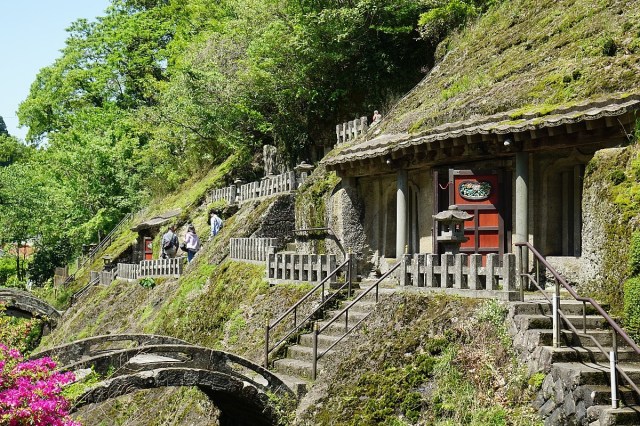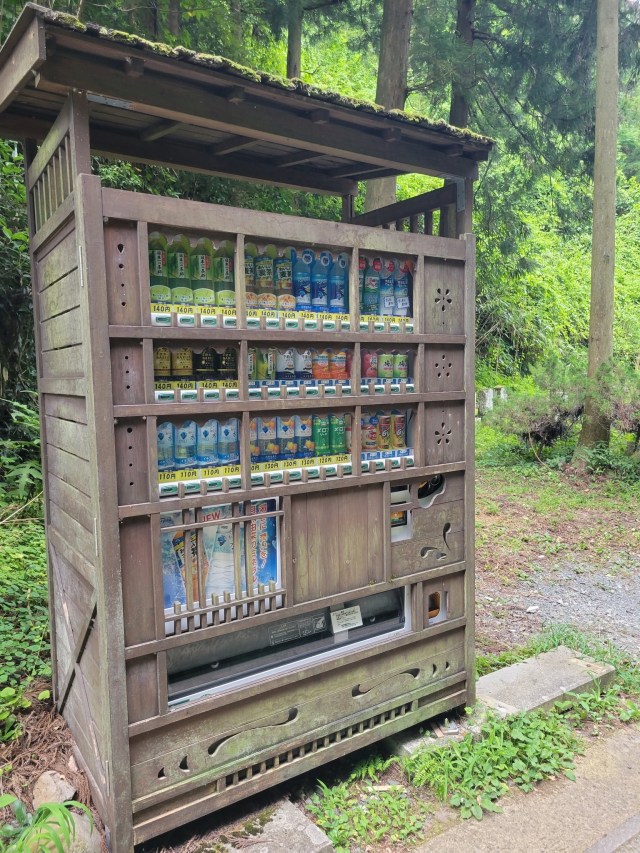
Silver town’s vending machine deserves a gold medal for design.
It seems like no matter where you go in Japan, you’re never very far from a vending machine. Ordinarily, that’s great, since having quick and easy access to a bottle of cold water of hot tea is definitely nice during the country’s sweltering summers and chilly winters.
However, while vending machines are a common enough sight that they sort of melt into the landscape of Japan’s urban and suburban neighborhoods, it’s a different story out in the country’s mountains and forests, where they can stick out like a sore thumb. Apparently that was a concern at Iwami Ginzan, a preserved silver mine in Shimane Prefecture (pictured above) that’s been designated as a UNESCO World Heritage Site. Yes, it’s understandable that visitors are going to get thirsty, but it’d be a shame for a vending machine to mar the view of the historical buildings and surrounding natural beauty, so Iwami Ginzan has a vending machine that blends in instead.
“A vending machine that’s very considerate of the scenery,” says @ekimemo_kinako, the Japanese Twitter user who snapped the photo. While it offers the familiar lineup of green tea, water, coffee, and sports drinks that you’ll find it just about any Japanese vending machine, there’s hardly any modern sheet metal to be seen, and instead the visible exterior is a beautifully understated wood carving, with subtle flourishes keeping with traditional Japanese architectural aesthetics.
景観に配慮した自動販売機 pic.twitter.com/hOPn6tARRv
— きなこもち (@ekimemo_kinako) August 8, 2021
Commenters were equally charmed by the considerate and gorgeous design, which looks like it predates automated commerce, reacting with:
“It looks like it’s been selling drinks since the Edo period.”
“Is there a person working inside of it?”
“I almost expect a panel to pop open and someone to stick their hand out when you pay.”
“I bet Totoro hangs out nearby.”
While the vending machine wasn’t actually installed in the samurai era, or the vague several decades ago of My Neighbor Totoro, it’s not brand-new either. It was originally installed in 1996, and while the wooden exterior is a frame that was built around the machine (look closely, and you’ll see hinges on its left side so that the front section can be swung open when the machine needs to be restocked), the craftsmanship wasn’t cheap, costing about 300,000 yen (US$2,750). Still, the investment was deemed worth it to preserve the scenery, and after 25 years in service, it’s started to take on a rustically weathered look, complete with some moss on the roof showing its now get a history of its own.
Source: Twitter/@ekimemo_kinako, IT Media
Top image: Wikipedia/663highland
Insert image: Twitter/@ekimemo_kinako
● Want to hear about SoraNews24’s latest articles as soon as they’re published? Follow us on Facebook and Twitter!


 We try fresh orange juice squeezed for us by a vending machine in Saitama【Taste test】
We try fresh orange juice squeezed for us by a vending machine in Saitama【Taste test】 Send a free drink to a friend with Japan’s newest coinless vending machines【Video】
Send a free drink to a friend with Japan’s newest coinless vending machines【Video】 Japan’s newest vending machine absorbs CO2 from the environment
Japan’s newest vending machine absorbs CO2 from the environment Sushi from a vending machine — would you try it? Mr. Sato did
Sushi from a vending machine — would you try it? Mr. Sato did First-ever foot-operated vending machine appears in Japan during pandemic
First-ever foot-operated vending machine appears in Japan during pandemic Foreign traveler caught trying to sneak into Japan by climbing down rope from cruise ship
Foreign traveler caught trying to sneak into Japan by climbing down rope from cruise ship Orange Juice Crisis ’24 – Japan’s OJ supplies drying up
Orange Juice Crisis ’24 – Japan’s OJ supplies drying up Bad tourist manners at Mt Fuji Lawson photo spot prompts Japanese town to block view with screens
Bad tourist manners at Mt Fuji Lawson photo spot prompts Japanese town to block view with screens Starbucks at Shibuya Scramble Crossing reopens, but is it really bigger and better than before?
Starbucks at Shibuya Scramble Crossing reopens, but is it really bigger and better than before? One of Japan’s oldest castles now lets travelers spend night on the grounds, drink in its keep
One of Japan’s oldest castles now lets travelers spend night on the grounds, drink in its keep Studio Ghibli unveils new goods that tip the hat to The Cat Returns
Studio Ghibli unveils new goods that tip the hat to The Cat Returns McDonald’s Japan’s new pancake pie is a taste sensation
McDonald’s Japan’s new pancake pie is a taste sensation Two things to do, and two things not to do, when leaving a traditional Japanese inn
Two things to do, and two things not to do, when leaving a traditional Japanese inn Foreigner’s request for help in Tokyo makes us sad for the state of society
Foreigner’s request for help in Tokyo makes us sad for the state of society Hatsune Miku comes to Magic: The Gathering with official crossover cards【Photos/Video】
Hatsune Miku comes to Magic: The Gathering with official crossover cards【Photos/Video】 Red light district sushi restaurant in Tokyo shows us just how wrong we were about it
Red light district sushi restaurant in Tokyo shows us just how wrong we were about it Japanese city loses residents’ personal data, which was on paper being transported on a windy day
Japanese city loses residents’ personal data, which was on paper being transported on a windy day McDonald’s new Happy Meals offer up cute and practical Sanrio lifestyle goods
McDonald’s new Happy Meals offer up cute and practical Sanrio lifestyle goods Japanese ramen restaurants under pressure from new yen banknotes
Japanese ramen restaurants under pressure from new yen banknotes Ghibli Park now selling “Grilled Frogs” from food cart in Valley of Witches
Ghibli Park now selling “Grilled Frogs” from food cart in Valley of Witches New definition of “Japanese whiskey” goes into effect to prevent fakes from fooling overseas buyers
New definition of “Japanese whiskey” goes into effect to prevent fakes from fooling overseas buyers Our Japanese reporter visits Costco in the U.S., finds super American and very Japanese things
Our Japanese reporter visits Costco in the U.S., finds super American and very Japanese things All-you-can-drink Starbucks and amazing views part of Tokyo’s new 170 meter-high sky lounge
All-you-can-drink Starbucks and amazing views part of Tokyo’s new 170 meter-high sky lounge More foreign tourists than ever before in history visited Japan last month
More foreign tourists than ever before in history visited Japan last month New Pokémon cakes let you eat your way through Pikachu and all the Eevee evolutions
New Pokémon cakes let you eat your way through Pikachu and all the Eevee evolutions Disney princesses get official manga makeovers for Manga Princess Cafe opening in Tokyo
Disney princesses get official manga makeovers for Manga Princess Cafe opening in Tokyo French Fries Bread in Tokyo’s Shibuya becomes a hit on social media
French Fries Bread in Tokyo’s Shibuya becomes a hit on social media Sales of Japan’s most convenient train ticket/shopping payment cards suspended indefinitely
Sales of Japan’s most convenient train ticket/shopping payment cards suspended indefinitely Sold-out Studio Ghibli desktop humidifiers are back so Totoro can help you through the dry season
Sold-out Studio Ghibli desktop humidifiers are back so Totoro can help you through the dry season Japanese government to make first change to romanization spelling rules since the 1950s
Japanese government to make first change to romanization spelling rules since the 1950s Ghibli founders Toshio Suzuki and Hayao Miyazaki contribute to Japanese whisky Totoro label design
Ghibli founders Toshio Suzuki and Hayao Miyazaki contribute to Japanese whisky Totoro label design Doraemon found buried at sea as scene from 1993 anime becomes real life【Photos】
Doraemon found buried at sea as scene from 1993 anime becomes real life【Photos】 Tokyo’s most famous Starbucks is closed
Tokyo’s most famous Starbucks is closed One Piece characters’ nationalities revealed, but fans have mixed opinions
One Piece characters’ nationalities revealed, but fans have mixed opinions We asked a Uniqlo employee what four things we should buy and their suggestions didn’t disappoint
We asked a Uniqlo employee what four things we should buy and their suggestions didn’t disappoint Thirsty buyer trolled by Japanese “mystery” vending machine, gets a liquid, but not one to drink
Thirsty buyer trolled by Japanese “mystery” vending machine, gets a liquid, but not one to drink Coca-Cola gears up for the Tokyo 2020 Olympics with crazy tall vending machine in Japan
Coca-Cola gears up for the Tokyo 2020 Olympics with crazy tall vending machine in Japan Aged vending machine in Tokyo appears to sell stag beetles
Aged vending machine in Tokyo appears to sell stag beetles Some of Japan’s most iconic vending machines will soon be no more
Some of Japan’s most iconic vending machines will soon be no more We hope you’re not thirsty — Tokyo shuts down its vending machines for U.S. president’s visit
We hope you’re not thirsty — Tokyo shuts down its vending machines for U.S. president’s visit Japanese vending machines now have the strangest thing we never knew we needed: hot bottled water
Japanese vending machines now have the strangest thing we never knew we needed: hot bottled water Vending machine makes commuters smile at Japanese train station
Vending machine makes commuters smile at Japanese train station The most vandalised vending machines in Japan? We check out a grungy duo at America Village
The most vandalised vending machines in Japan? We check out a grungy duo at America Village To prevent heatstroke and COVID-19, Ibaraki vending machines dispense free cold water to students
To prevent heatstroke and COVID-19, Ibaraki vending machines dispense free cold water to students Weird Japanese vending machine comes with a heartwarming twist
Weird Japanese vending machine comes with a heartwarming twist Tokyo vending machine sells beautiful shugifukuro money envelopes for wedding and other gifts
Tokyo vending machine sells beautiful shugifukuro money envelopes for wedding and other gifts Japanese vending machines will now let your buy things using your face
Japanese vending machines will now let your buy things using your face Japanese vending machines set to become cooler than ever by selling sub-zero soft drinks
Japanese vending machines set to become cooler than ever by selling sub-zero soft drinks Japan’s first beef bowl vending machine goes into service in Tokyo
Japan’s first beef bowl vending machine goes into service in Tokyo Titan trash can to be placed near a Coca-Cola vending machine in Oita to help promote recycling
Titan trash can to be placed near a Coca-Cola vending machine in Oita to help promote recycling Cat paw button vending machine debuts in Japan to celebrate Cat Day
Cat paw button vending machine debuts in Japan to celebrate Cat Day Japanese drink vending machine capsule toys: A must-have for recreating Japan in miniature
Japanese drink vending machine capsule toys: A must-have for recreating Japan in miniature
Leave a Reply